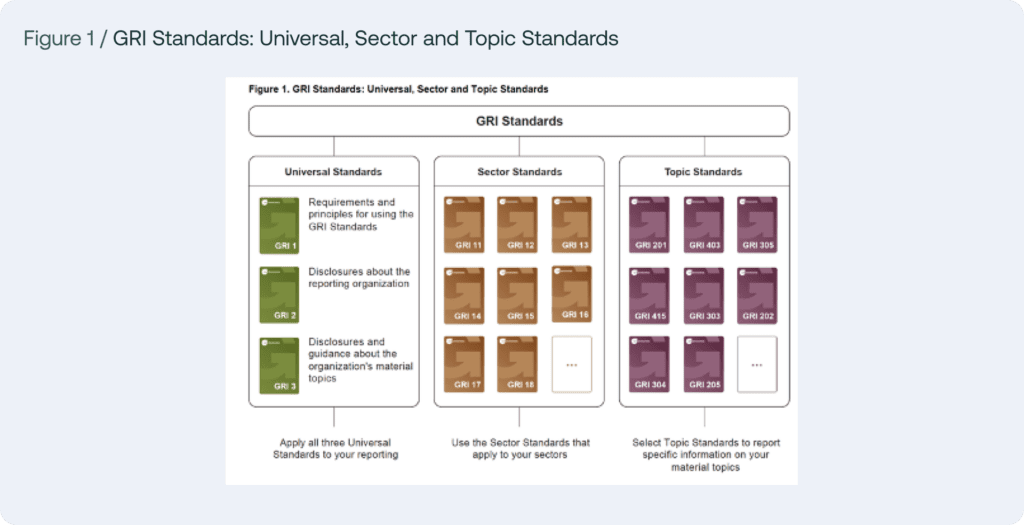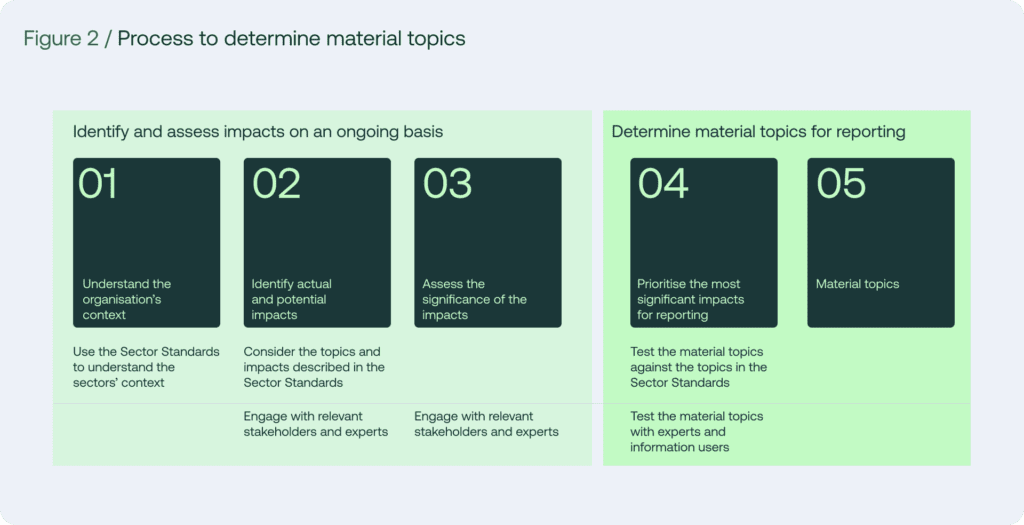



Sustainability reporting is a process that starts with an organisation determining its material topics based on its most significant impacts on the economy, the environment, and people, including its impacts on people’s human rights.
Establishing a reliable framework for sustainability reporting is essential for driving progress on the issues that matter most – from carbon emissions to biodiversity. Set up over 25 years ago, the Global Reporting Initiative (GRI) has developed the most widely used sustainability reporting standard, adopted by more than 14,000 organisations worldwide.
But with a range of sector- and topic-specific standards, it’s important to clarify how to incorporate the GRI Standards into your reporting strategy. This blog provides a detailed overview of what to expect from the GRI reporting process, and how your company can prepare for successful compliance.
Among the most frequently asked questions asked by clients who want to start GRI reporting are ‘Who can report?’ and ‘When should I start?’. The first question is simple to answer. GRI reporting is an option for any organisation, regardless of size, type, country of operation or reporting experience. The answer to the ‘when’, question is more complex.
The GRI Standards are voluntary, so there’s no legal requirement to report in line with them. However, shareholders and other value chain partners may request it as evidence of your progress on sustainability matters.
In addition, GRI compliance can be a useful stepping stone towards compliance with legally binding reporting standards, such as the CSRD.

There are therefore many benefits to kicking off the process as soon as you can. And the best starting point is understanding and identifying what specific disclosure requirements apply to your company. This is essential to facilitate the data-gathering process, as well as the materiality assessment and stakeholder engagement. These steps are often time-consuming and need to be conducted regularly to ensure your reporting remains up to date.
Covering a wide range of environmental, economic and social topics, the GRI Standards are renowned for their comprehensiveness. And in 2021, GRI released its new reporting standards. These are mandatory for reports published after 1 January 2023.
Several sector-specific standards have also been published since, including GRI 13: Agriculture, Aquaculture and Fishing Sectors 2022. Below, we break down the differences between the standards and explain how to determine which ones apply to your company.


GRI 1: Foundation 2021 explains the ‘why’ and ‘how’ of reporting against the GRI Standards. It highlights their purpose and the key principles to follow when reporting. It also explains the following key concepts.
The GRI Standards include a set of principles to guide the reporting process, ensuring your organisation’s sustainability performance is represented fairly and accurately. The principles are listed below.
Under the GRI Standards 2021, the only two options available are to report ‘in accordance with’ the standards and ‘in reference to’ the standards.
This is the most rigorous option, requiring compliance with all nine requirements highlighted in the Standards. Companies that want to report ‘in accordance with’ the GRI Standards 2021 will need to:
For companies starting on their GRI journey, reporting ‘in reference to’ the GRI Standards can be a first step towards full compliance, providing a more accessible pathway. It has fewer requirements than reporting ‘in accordance with’ the GRI Standards, requiring organisations to:
The standard GRI 2: General Disclosures aims to present the profile of the reporting entity by looking at: the organisation and its reporting practices, its activities and people, its governance structures, its strategy, policies and practices, and its stakeholder engagement approach.
This section guides how an organisation should determine, disclose and manage its material topics. The process starts with a materiality analysis, through which an organisation can identify the most significant environmental and social impacts it generates. To conduct a materiality analysis, you need to:


The reporting organisation must disclose the process used to identify and prioritise material topics.
The organisation must disclose the list of all material topics identified through the materiality analysis. The results may also be presented in a sustainability materiality matrix, to be referenced in the content index.
The organisation must describe the actual and potential, both negative and positive, that it generates. For each material topic, the reporting entity must disclose the actions taken to manage the topic and its related impacts.
Through its Sector Programme, the GRI is in the process of developing specific Sector Standards for 40 industries, starting with those that generate the largest environmental impacts. These standards support organisations in their sustainability reporting by defining material topics for their industry, as well as key information they need to disclose.
The Sector Standards are currently available for the following sectors:
If your organisation operates in one of the above sectors, you should use the Sector Standards when preparing your sustainability report. These can be found in the GRI Resource Centre.
If a specific Sector Standard is not yet available for your industry, you should select the Topic Standards relevant to your organisation.
The GRI Topic Standards are applied based on the material topics identified through the materiality analysis. Each standard provides an overview of exactly what the reporting entity should disclose on that topic. Therefore, organisations should select the Topic Standards that correspond to their material topics and use them to guide their reporting.
Below are some examples of Topic Standards:
The Topic Standards are also available in the GRI’s Resource Centre.
Disclosing your sustainability efforts in line with the GRI Standards is about much more than showcasing your performance on environmental and social topics to stakeholders. Indeed, the transparency, comprehensiveness and specificity of the standards make them a valuable tool to guide and provide clarity on your sustainability strategy – enabling more consistent performance measurement and improved risk management.
Producing a GRI-compliant report can also provide reputational benefits, both in terms of improving employee engagement and facilitating collaboration with customers and other value chain partners. In addition, more than 40 stock exchanges around the world require companies to use the GRI Standards for sustainability reporting.
The GRI Standards are also closely aligned with other international sustainability standards, such as the ISSB disclosure standards. GRI reporting can therefore help you meet a range of regulatory and stakeholder requirements – potentially paving the way for B Corp certification or a higher EcoVadis rating. It’s also a valuable tool for measuring your organisation’s performance over time and benchmarking against competitors.
Yes, you can report ‘with reference to’ the GRI Standards (as opposed to ‘in accordance with’ the Standards). While you must still follow the eight reporting principles, you do not need to adhere to all nine reporting requirements. Instead, you only need to (1) publish a GRI content index (2) provide a statement of use and (3) Notify GRI.
You don’t need to have your report certified by GRI to publish it with the GRI logo. However, you must comply with the nine reporting requirements and the eight reporting principles. Once you have produced a sustainability report in accordance with the GRI standards, you need to notify the GRI.
Concerning the materiality analysis, both standards require such an analysis to be conducted. There are guidelines and suggestions on how to carry it out, but these steps themselves aren’t mandatory. The only requirement is that the analysis is completed and the process described.
All resources can be found on the GRI website by following this link.
The 2021 Standards have been in effect for reporting since 1 January 2023.
If your organisation cannot comply with a specific disclosure or requirement, you must provide a valid reason for the omission. In particular, the organisation should highlight missing information in the content index and provide one of the following four reasons for omission:
To notify GRI, you can use the GRI Standards Report Registration System. Your submission may take some time to process, but this will not affect your compliance with the notification requirement.